& beyond the about
patrick brennan
October 2019
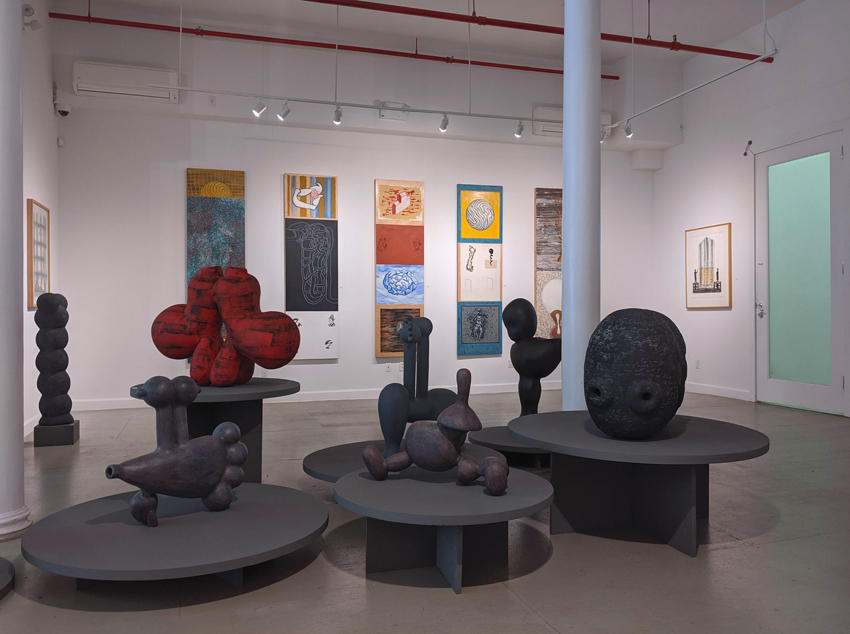 Installation View, IN-TER-WO-VEN. Miriam Bloom & Ron Morosan. Exhibition curated by James Cavello.
Installation View, IN-TER-WO-VEN. Miriam Bloom & Ron Morosan. Exhibition curated by James Cavello.
September 20 – November 16, 2019. WESTWOOD GALLERY NYC, 262 Bowery, New York, NY 10012
“No Ideas but in Things.”… “Truth itself should be in the manner of work”. “Something is what it is and as it is.” “The point is to discover the thingly character of the thing.” “Unconcealedness sets itself into work.” … “Life is Probably Round.” Quotes from William Carlos Williams, Martin Heidegger & Vincent Van Gogh respectively are written in white chalk on a black surface, part of a quasi-manifesto covering the wall to the left as one enters Westwood Gallery as part of an installation that incorporates pieces by Miriam Bloom, sculptor, & painter Ron Morosan.
The art of each is the focus of this two person retrospective IN-TER-WO-VEN. Both have, over decades, cultivated thoroughly lived, uncompromising artistic visions that have oftentimes swum well informedly upstream against the au courant. This distinctiveness may require us to “grow new eyes” in order to discover how to see their work, a mark of just how much both have to offer.
At a glib, very quick, first impression, for example, there could be some temptation to surmise that each of these artists might reveal some slight penchant for the cartoon; and while not yet having found my way into the resonances of Bloom’s sculptures, I initially jumped at oblique implications of inflated rubber gloves, or after some possible distant tactile kinship with the bulbous evocations of Tom Otterness or Jeff Koons.
Both of these sculptors, however, very much unlike Bloom, are deliberate crowd pleasers: Otterness tends toward wry, but still cute, caricature, while Koons reassures financial elites with the prestige of kiddie porn glitz.
Bloom’s sculptures, in significant contrast with this, point way, way, way somewhere else, well beyond her work’s immediately evident craft & care and their very subtly tuned colorations & textures, quietly sounding what prevailing noise almost invariably obscures.
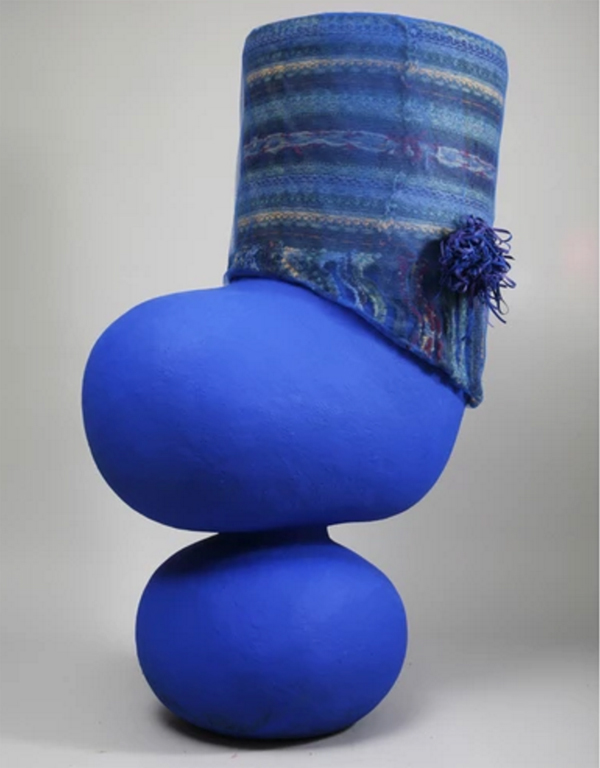 MIRIAM BLOOM, Clouds and Sand, 2010, mixed media, 50 x 17.5 x 30 inches.
MIRIAM BLOOM, Clouds and Sand, 2010, mixed media, 50 x 17.5 x 30 inches.
Image © Miriam Bloom. Courtesy WESTWOOD GALLERY NYC.
It did take me more than a moment to reconfigure my own perceptions (& preconceptions) to tune to what exactly is happening with these terra cotta & layered, handmade paper sculptures. A breakthrough introduced itself while viewing Clouds and Sand & All the Dreams You Show up in Are Not Your Own side by side.
These, like all of her work in this exhibition, are vessels rather than having been extracted from solid blocks of a core material. The shapes are more enigmatic than not. One is colored matte blue, the other matte red. The absorbent, monochrome hues of each are at once both subtle & arrestingly intense. Both are partially adorned with hand woven wool fabric, “couture” that reminded me just a bit of Jeffrey Gibson’s regalia adorned punching bags, but, from there, their respective tales diverge.
Bloom’s shapes here are evocatively figure-like, however, with neither face, front, nor even such outgoing surfaces that would assertively reach out (Look at me! Look at me!) toward their viewers. I flashed that these are extraordinarily introspective artworks, relatively unconcerned with the outside, dwelling pensively upon the reverberations of their own hollow interior cavities, placentas distantly reminiscent of some of those large, never to be played drums of West Africa that listen for the beat that is never sounded.
This shifted the frame I’d been bringing earlier to other works such as the polychromed terra cotta First Base, which presents a winglike, four toed foot, from the top of which sprout two parallel, vertical, armlike cylinders that each culminate as nippled, spherical breasts. Intimate & withdrawn from light as the interiors of these vessels may be, there’s, nevertheless, no shortage of outward playfulness or whimsy.
One might incline to perceive the plethora of shapes that evolve throughout this body of work as water driven, but it turns out that air is the literally inspirational formative force behind & within all of these sculptures — not some robber baron conception of atmosphere as an invisible free lunch that’s gag ruled to blank check pollution & abuse, but the amniotic power of winds that blow, breathe, propel, listen, connect, clarify & communicate, winds that precede & supersede what may eventually appear as form.
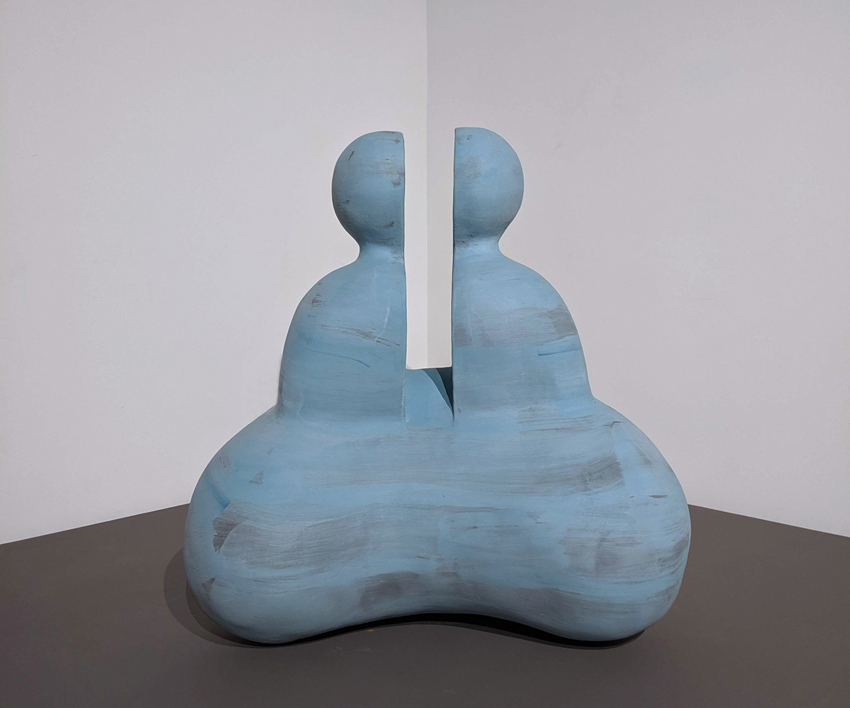 MIRIAM BLOOM, Sababa Bodhi, 2004 ceramic stoneware with pigmented slip, 20 x 19 x 12 inches.
MIRIAM BLOOM, Sababa Bodhi, 2004 ceramic stoneware with pigmented slip, 20 x 19 x 12 inches.
Image © Miriam Bloom. Courtesy WESTWOOD GALLERY NYC.
Perhaps the most signal & powerful among these works might be Sababa Bodhi, a highly synthetic image whose back-history traces a full gestational seven years of trial, error, experiment & continuous readjustment. The forward profile somewhat loosely connotes a cross-legged, Buddha-like figure, but this soft, curvilinear presence encounters one of the most densely packed interjections of negative space that I can remember witnessing.
Directly through what would be the center of a figure’s head interposes a severe rectangular cut from top down almost to what might be a waist. The single near figure consequently splits into something like two heads & shoulders intimately face to face across the center in profile to the viewer. But, the shapes are not at all so simple. This is a straight edged cutaway. The surfaces that silhouette the two “faces” are blank flat like polished floor, glass or mirrors.
The cutaway asserts an emphatic absence. Is this a lighting bolt of insight or a literal flash of somatic electricity? Is it the gaping grief of no possible return or reconciliation? Is it the opening of the inner to the light or the insertion of the ultimate shit detector, the hardest edge of self imposed honesty? Is this the break that births multiplicity or reflections on the ultimate conflict of interest?
Are the silhouettes endlessly recursive mirrors of each other, a narcissist’s wet dream, or is this rapture, sexual & otherwise, of intimate partners as each beholds the other? Or, is it only a dream in the imagination of the sitter? This is part of the beauty of this piece, so fecund with implication, in that it insists on no single association, a breathtaking accomplishment in saying, or alluding to, so much with such extraordinary formal economy.
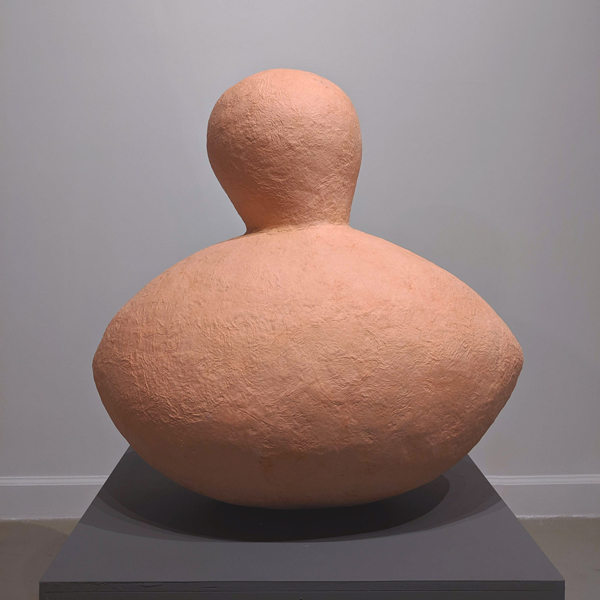 MIRIAM BLOOM, Sea Theory, 1998, handmade paper over armature, 26 x 25 x 14 inches.
MIRIAM BLOOM, Sea Theory, 1998, handmade paper over armature, 26 x 25 x 14 inches.
Image © Miriam Bloom. Courtesy WESTWOOD GALLERY NYC.
While Bloom blankets the invisible with sculpture that nurtures & muses over what can’t be seen, Morosan is equally engaged in an ambition to articulate what can’t be seen within a distinctly visual medium, in this case, painting. He’s concerned with how the mind works, with cognitive capacities & tendencies, with the entire process of how people look at art within this culture, the act of seeing itself, all arguably vying to inform an art about art, conceivably a meta-art.
However, Morosan has never played footsies with notions of the “end of art” or the “death of painting”. He’s never conceded to a hierarchy that would prioritize the authority of critics or curators over the people who do the actual work, nor has he toyed with the flippant irony about art about art about art that plenty of “postmodernists” indulged in to get themselves both off the hook & into the big leagues, nor has he ever affected the Olympian asceticism (one has to remember here that both Greek & Yoruba polytheistic deities have long deeply envied the fleshy presence & experience of mortal human actuality) & self denial propounded by those who are so much smarter than art itself that they retreated to language (while still retaining a luxurious access to museum & gallery prestige that’s outright denied to poets & other writers) as “conceptual” artists.
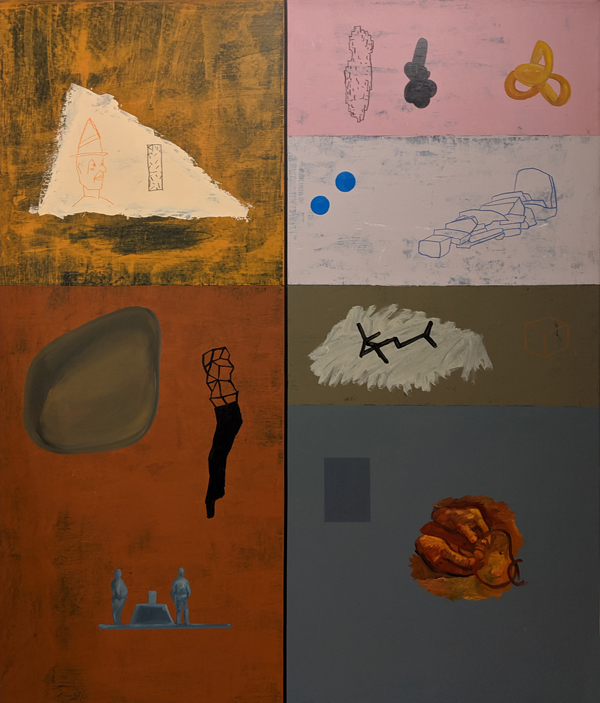 RON MOROSAN, Struggle for Nature 1995, oil and acrylic, 48 x 44 inches.
RON MOROSAN, Struggle for Nature 1995, oil and acrylic, 48 x 44 inches.
Image © Ron Morosan. Courtesy WESTWOOD GALLERY NYC.
The artist most fashionably associated with cognition in art was that notable refuser de peindre R. Mutt (alias Henri Robert Marcel Duchamp), whose distinctive mannerisms have since paved profitable career paths for scores of art history PhDs & curators. Loyal to Ancien Régime Cartesian presuppositions, Mutt, asserted that mind must disassociate itself from “animal expression” & “retinal art” as if the eye were not at all closely associated with, or even a part of, the brain, for example.
While Mutt’s long, publicly performed holiday from painting found solace in the far from stochastic security of chessboard patterns, Morosan considers that the work that is painting is never finished, that, as with breathing, the question “what is it to see?” can’t be indefinitely adjudicated by summary decree. The question of seeing persists existentially as a recurrent, present tense concern that can’t be eclipsed by conveniences of concept.
Furthermore, painting, far more than even photography or cinema, accomplishes an active, projective seeing, a working out, through the intelligence of the hand, of how one sees by articulating, more or less from scratch, something to look at that’s external to oneself. “Retina” plays, in this context, relay, no passive mechanical receptor. Seeing reaches out to present something yet unseen. Sight executes a reciprocal dialogue between beholder & beheld in an ever negotiable feedback loop.
In asking how he himself sees, as a painter, Morosan discovered some specific challenges. One is to paint, not to illustrate. None of that “painted word” business that Tom Wolfe flippantly misappropriated to mock Abstract Expressionists. The challenge is not to provide an accompanying illustration for what can be better said in words in the first place (check out some of the apologies issued as artist statements or press releases to compensate for otherwise vacuous visual presentations), but to wrestle with even philosophical conundrums in specifically painterly terms: color, shape, image, composition, texture, dimension — in terms of a physical presence that addresses the body of the viewer as a whole.
Having often concerned himself with generalized abstract concepts, social relations, neural networks, complexity theory & mathematics, the continuous experience of being inundated by volumes of unrelated, technologically generated imagery, the contradictory nature of an ever morphing zeitgeist, the Trojan horse of artificial intelligence’s aspiration to cancel knowledge & experience in favor of information, many of Morosan’s core interests are not in themselves especially painting friendly. Incorporating this wide ranging sensibility & curiosity into his painting identifies one of the primary tasks he’s taken on. And, to further thicken the plot, he’s additionally aspired to integrate awareness of context into a painting, to comment on the painting itself as well as on the social milieu within which it is perceived.
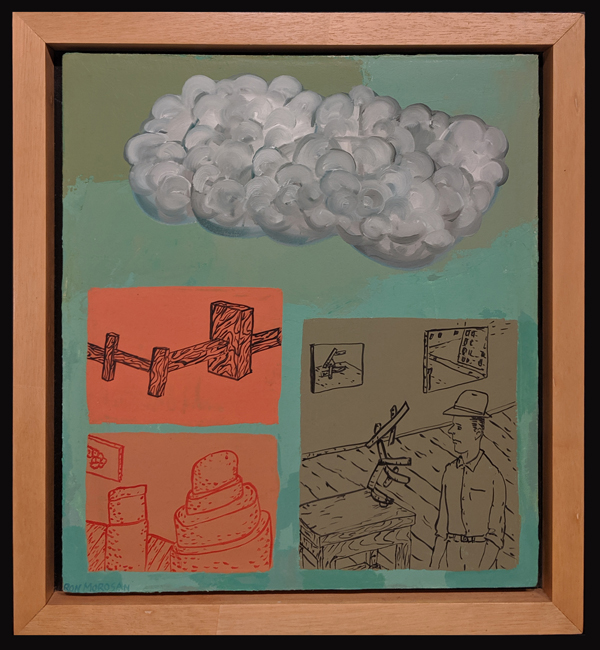 RON MOROSAN, Art Viewer in Complex Social System, 2014-17, oil and acrylic on canvas, 24 x 22 inches.
RON MOROSAN, Art Viewer in Complex Social System, 2014-17, oil and acrylic on canvas, 24 x 22 inches.
Image © Ron Morosan. Courtesy WESTWOOD GALLERY NYC.
He might have had a much easier time contending with all this as a philosopher, researcher, critic or speculative thinker writing books & essays, but this is exactly the point of engaging these ideas as painting. One might otherwise expect responses to such subjects to be couched in charts & diagrams, but the precise & vital limit of technocratic disposition is what it excludes (many economists, for example, seem to feel, at most, only minor qualms around recommendations that consign large numbers of people, people who don’t “really count”, to further exacerbated poverty in order to augment some macrostatistic), whereas art is already predisposed to synthesize more reality at broader & deeper levels of organization & integration.
Many of Morosan’s earlier paintings are staged like one frame exhibitions containing among other elements, a number of constituent bounded areas. However, these squares & rectangles feel refreshingly free of taints of that oppressive substitute for exploration so treasured by minimalists, the unexamined, prefab grid. These contain multiple images corresponding to a theme being considered, each from a different perspective (which is, effectively, an extension of Cubist awareness). Some of these inhabitants resemble graphic novel characters, a dog, or a bird, or a regular Joe white guy working man deadpan contemplating an apparently cryptic abstract sculpture in a gallery. Others present gnarled, curious shapes or portraits of cerebella.
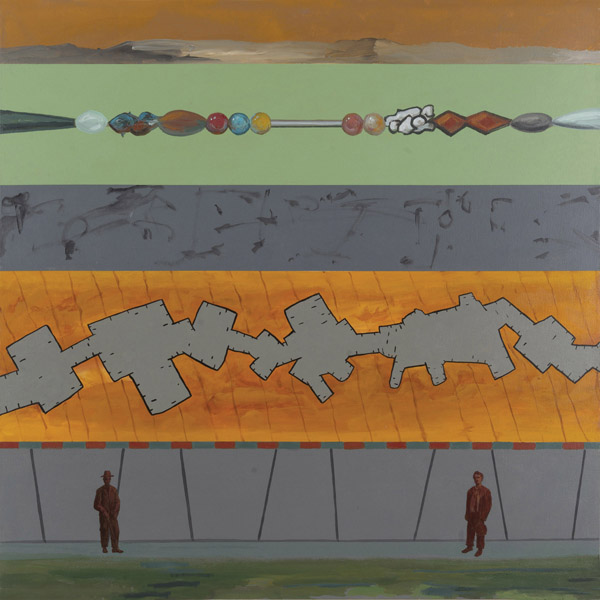 RON MOROSAN, Dual Quad Rational, 2017, acrylic on canvas, 42 x 42 inches.
RON MOROSAN, Dual Quad Rational, 2017, acrylic on canvas, 42 x 42 inches.
Image © Ron Morosan. Courtesy WESTWOOD GALLERY NYC.
More recent paintings, such as the 1995 Struggle for Nature & the series dating from 2017 on (Dual Quad Rational, Segment, & Parallel) continue & encapsulate so much of what distinguishes the entire collection. Although Basquiat & Morosan might otherwise differ in almost every other way, they do share a notably roving, even self contradictory, internal diversity of content & imagery as well as a pluralistic application of painterly techniques, materials & textures, all without, unlike so many others, splitting into fragmentation, collage, pedantic illustration or caricature. Even letters & words succeed pictorially within these paintings.
Morosan courts exponential comparison within each painting, each difference displaying just enough visual homonym to ignite strings of associations that comment reciprocally on the other in a never ending, non-linear dialectic, superbly integrating painterly motion & composition with the insatiable movement of the mind as question.
If you do happen to have access to New York City, see both of these artists’ work in person. No photographs or linguistic description can give even half a clue to all there is to witness.
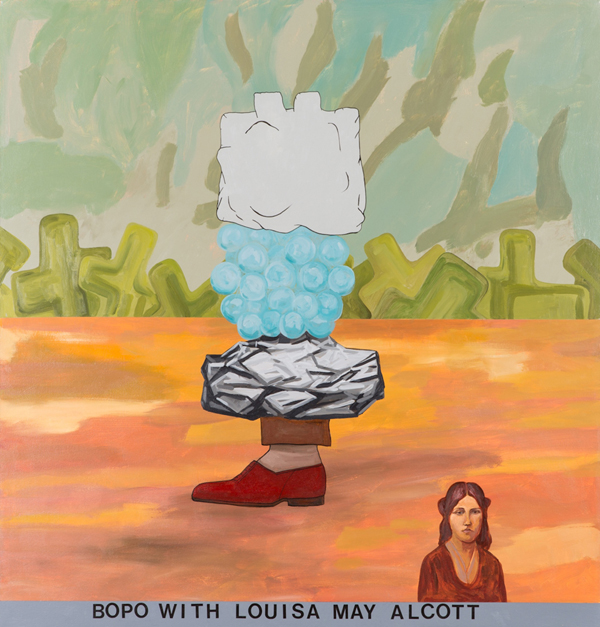 RON MOROSAN, Bopo with Louisa May Alcott, 2013, oil on canvas, 44 x 42 inches.
RON MOROSAN, Bopo with Louisa May Alcott, 2013, oil on canvas, 44 x 42 inches.
Image © Ron Morosan. Courtesy WESTWOOD GALLERY NYC.
IN-TER-WO-VEN
WESTWOOD GALLERY
262 Bowery, NYC
September 20 – November 16
◊
patrick brennan coordinates ensembles, composes & plays the alto saxophone, pursuing a contrarian and independent musical path within the Blues Continuum toward the evolution of a distinct musical language that explores multidirectional thinking, organization, time, sound, line & rhythm. Recordings include terraphonia (Creative Sources), muhheankuntuk (Clean Feed), which way what, and Sudani (deep dish).
